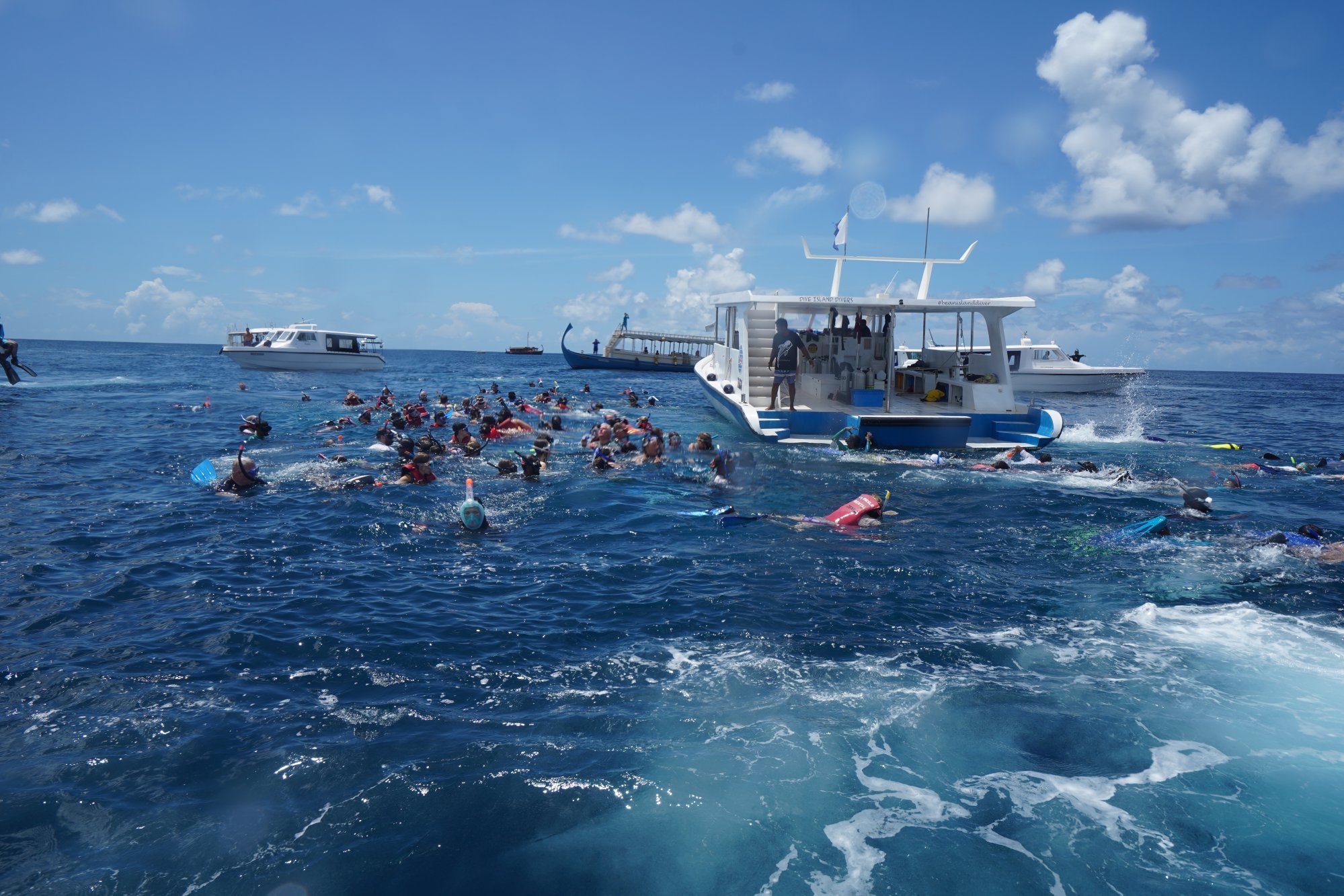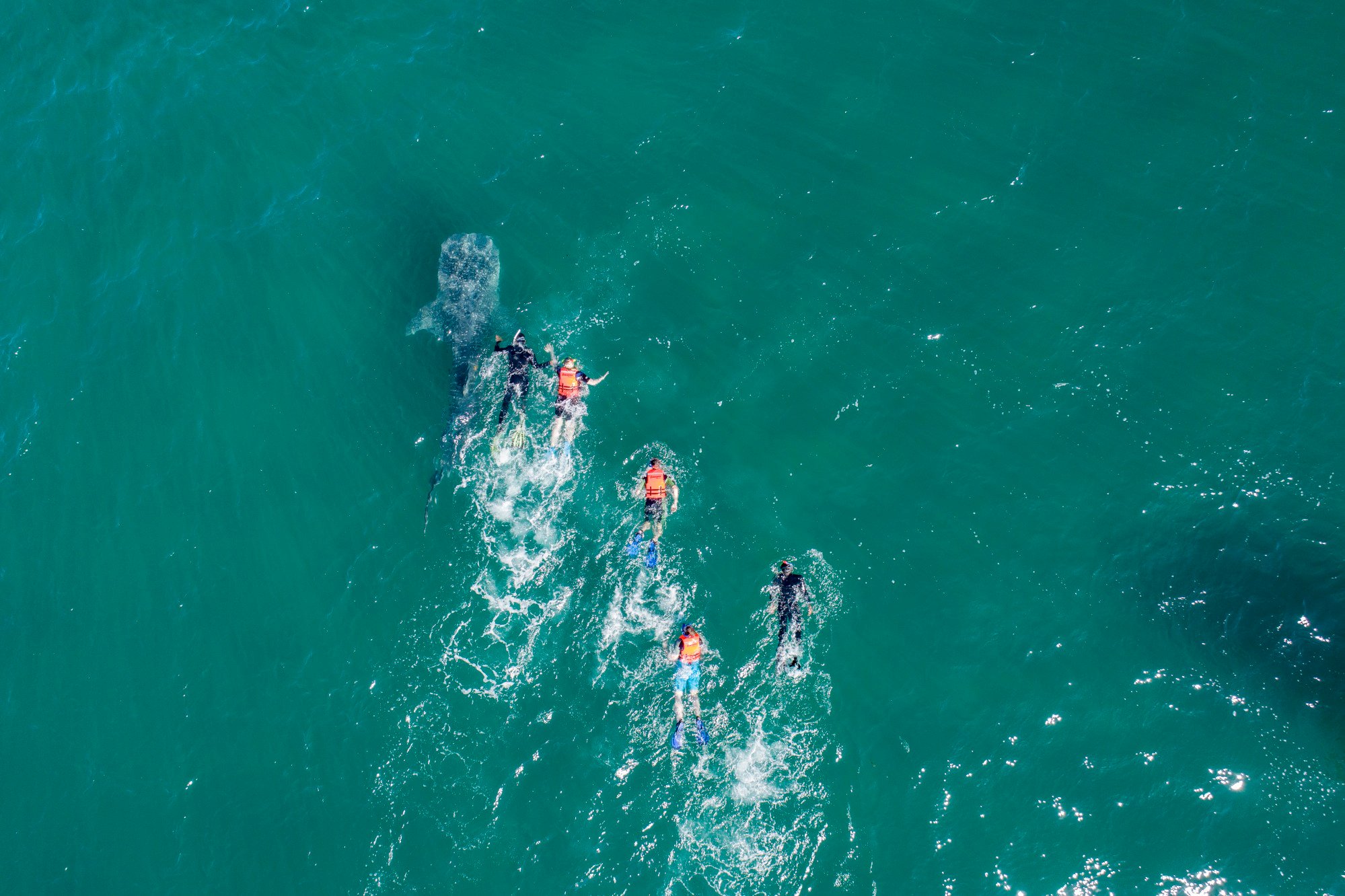
‘Pure chaos’: how whale shark tourism in Maldives is out of control and puts the magnificent creatures’ lives at risk
- Dozens of boats and hundreds of tourists can be in the water at a time chasing one shark. Nearly half of whale sharks in one area showed major injuries in 2019
- Enforcement can drive change, as Mexico has shown. If captains or guides break any rules, they risk a fine of up to US$13,000 and even up to nine years in jail
Swimmers move urgently through the warm, clear, turquoise waters. These are tourists on a mission – to photograph a whale shark, the world’s biggest fish. Surrounding the animal, they dive on top of one another, kicking each other’s fins.
The creature ignores the frenzy and continues to cruise through the shallow reef waters, searching for plankton to draw into his wide mouth. Finally, it finds a drop-off, and dives into the mysterious deep ocean waters. The crowd disperses and each swimmer returns to one of the dozen or so waiting tourist boats.
The scene is not uncommon in South Ari Atoll. The Maldives, particularly this atoll, is one of only a few locations known for year-round, all-weather whale shark sightings.
However, the animals are endangered, and their population is decreasing worldwide. Unregulated tourism poses a threat to their survival.

Whale sharks help balance the marine ecosystem. They feed on plankton and seaweed, the foundation of the ocean food chain.
The white-spotted creatures can grow up to 18 metres (60 feet) long, although it is rare to encounter one larger than 10 metres beyond the waters of the Galapagos Islands. Those seen in the Maldives are almost exclusively juvenile males.
Bangkok’s oldest street reinvents itself – now it’s the hippest place to be
Whale sharks can also be found in the waters of Mexico, the Philippines, Mozambique, Tanzania and Indonesia.
According to field research conducted by the Maldivian-run NGO Maldives Whale Shark Research Programme (MWSRP), the number of whale sharks visiting the South Ari Atoll decreased from 48 in 2014 to 32 in 2019, correlating with an increase in injuries.
The percentage of sharks sighted with major injuries jumped from 24 per cent in 2006 to 45 per cent in 2019.
“These injuries are largely consistent with speedboat propellers,” explains MWSRP’s in-field coordinator Chloe Winn.
“While we cannot quantify whether these injuries happen within or outside the marine protected areas, the increase in whale shark injuries does correlate with an increase in vessels in these areas.”

Furthermore, Winn says, whale sharks are stressed by crowds of swimmers, and MWSRP teams have observed encounters involving 20 or more boats with dozens of people on each.
Jennifer Garnett, an American freediver, took part in a South Ari excursion in April.
“The experience was pure chaos. There were up to 50 boats and hundreds of people in the water, chasing one whale shark up and down the reef. It was hard to swim because you are surrounded on all sides by many poor swimmers,” she says.
“As a freediver, I was lucky that I could dive down just a little to get a clearer view of the whale shark.”

Garnett says she has swum with whale sharks in Mexico and the Galapagos, both of which were much safer experiences.
Sharks are also stressed by fast boats. “We have observed an increase in speeding [in protected areas] over the past few years,” Winn says. “While this behaviour is not typical of everyone, it does occur, and it is a problem for whale sharks who come to the area to recuperate after deep diving.”
Whale sharks cruise at the surface of shallow reefs to rest and regulate their body temperature after returning from cold depths with lower oxygen levels. The sharks may try to avoid interactions by swimming faster or diving, which affects the thermoregulation process.
Guides express that there is pressure to deliver the experience of seeing a whale shark to guests. After Covid-19, there is even more pressure
International tourism has grown as a key income generator for the Maldives since the 1970s. Diving tourism has become a crucial alternative source of income for local fishermen, especially since the Ministry of Fisheries, Marine Resources and Agriculture imposed a ban on fishing for sharks in 1995.
Maldivian fishing communities had occasionally hunted whale sharks for their fins and liver oils, which were used to waterproof boat hulls. The ban was introduced to encourage those communities to move away from harmful fishing.
The Maldivian government designated the South Ari Atoll as a Marine Protected Area (MPA) in 2009.

In 2019, the Maldives Environmental Protection Agency (EPA) implemented a code of conduct for whale shark tourism operators in the South Ari Atoll, which included that:
-
Divers and snorkellers should stay three to four metres from the animal and refrain from flash photography
-
They should not touch the creatures or interfere with their direction of movement.
-
Boats should not go faster than 10 nautical miles per hour (knots) in protected areas
-
The number of swimmers entering the water from a boat should not exceed 12.
But enforcement is lacking, explains Yoosuf Rilwan, a director with the EPA.
“A framework for diving or snorkelling with whale sharks exists, and the animals are technically protected under the endangered species law. But it is not enforced due to a lack of budget. Rangers have not been assigned to the South Ari area because there is no formal management plan.”
Pompeii and the Amalfi Coast in Italy: what to do and what to bear in mind
The EPA is trying to draw up a management plan, he adds, but this depends on budgets and resourcing.
Most of the boats that chase whale sharks in South Ari belong to resorts in the area, or are operated by companies that have been contracted by those resorts.
A handful of independent operations based on residential islands such as Mahibadhoo serve mostly clients who stay at local guest houses.
Winn notes that operators follow the conduct rules to varying degrees, but many do follow best practices, and most give a briefing to the guests.
Wildlife crimes: Hong Kong supermarkets found selling endangered animals
“A huge part of the briefing focuses on dos and don’ts, including no touching of the whale shark, no flash photography, and keeping three to four meters distance when swimming,” explains Rachelle Hill, the resort’s director of marketing and communications.
“[The resort’s] marine biologist and guides serve as atoll rangers, ensuring that all guests get the best experience while respecting the rules and ocean during the trip.”
The Conrad’s whale shark excursions are priced at around US$200 per resort guest, whereas the average cost among the various providers is US$100 to US$150 per person.
The three-legged tortoise with wheels who’s travelled half the globe
Poor marine behaviour is partly explained by unrealistic visitor expectations, says MWSRP scientist Clara Canovas Perez.
“Guides express that there is pressure to deliver the experience of seeing a whale shark to guests. After Covid-19, there is even more pressure due to businesses being shut down for a long time,” she says.
“Guest violations usually come down to an array of factors. Sometimes there are language barriers, guests do not absorb instructions well, some just outright do not want to abide by the rules, or individuals are not particularly comfortable in the ocean.
“[With the code of conduct] the Maldives has best practices in place on paper … however, the wider issues and means to solve them require the enforcement of the guidelines and a management plan that considers the quality of encounter over quantity.”

Enforcement can drive change, as Mexico has shown.
The Latin American country has also experienced an increase in whale shark tourists over the past decade, rising from just a few hundred to more than 12,000 annually.
In 2017, Mexico enforced a new conduct management plan in its primary whale shark regions, including the La Paz Bay to Isla Espiritu Santo area; Isla Holbox, in the Caribbean; and Bahia de Los Angeles.
Visible measures – including speed limits and restrictions on the number of authorised boats – have been implemented and regulated.
A limit of five people are allowed in the water with a certified guide at a time and they can approach a shark from one direction only.
In addition, a tourist fee of 30 pesos (US$1.50) is added to all excursions to fund patrols of protected areas.
Travel and dining boom in Japan as country learns to live with Covid-19
Guides and captains must undergo training and examinations. Boats are registered, geotagged and monitored for illegal entry into prohibited areas.
Under Mexican federal law, if captains or guides break any rules, they risk losing their license, a fine of up to US$13,000, and even up to nine years in jail.
“[Before the implementation of the management plan] problems occurred because of increased boat traffic coupled with a lack of guidelines to perform tourism activities, patrolling and enforcement,” explains Dení Ramírez Macías, director of research organisation Whale Shark Mexico.
“The success of the management plan was measured with an analysis of fresh injuries.”

Since implementing the management plan in La Paz Bay, for example, the percentage of injuries witnessed on all sighted animals decreased from 77 per cent in the 2016/17 period to 48 per cent in 2021/22.
Winn and Perez hope for similar enforcement in the Maldives.
“It’s a huge area to regulate,” Winn says. “But, if you follow the code of conduct, it means you will have a better encounter and a good impact on whale sharks instead of a negative one.”
Without enforcement, whale sharks continue to be at risk of injury and danger, and the Maldives risks losing these magnificent creatures.

